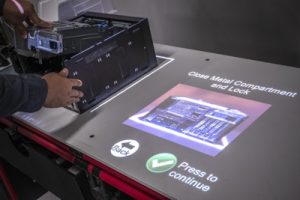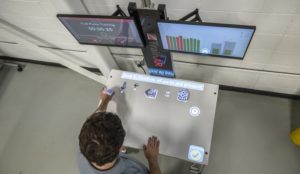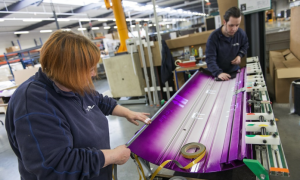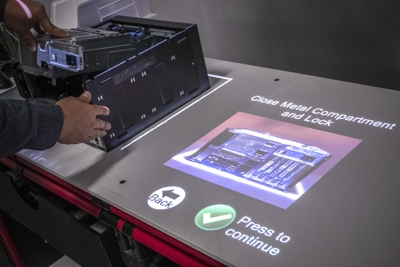Executive Summary
Every day, LightGuide is empowering people with disabilities to achieve greater success in the workplace. According to the World Economic Forum, 17% of the world’s population (1.3 billion people) live with some form of physical or mental disability.1 Leveraging new technology, people with disabilities can now perform work that was previously inaccessible to them.
Within industry, augmented reality (AR) is one of the foremost technologies helping individuals with disabilities enter and succeed in the workforce. This is beneficial on both a micro and macro scale; AR enriches the lives of those that are enabled to work through its inherent job-creation capabilities and AR increases the labor pool for companies while decreasing the number of government subsidies required.

Introduction
Of the 1.3 billion people worldwide living with a disability, approximately 1 billion are working age.2 Historically, it is much harder for those with a disability to gain employment, which can hurt their lifestyle by preventing access to the enrichment many find in their work.
Beyond the moral argument, the economy suffers when people are excluded from the workforce. In 2019, $145 billion (over 0.06% of the United States’ GDP) was spent on disability insurance, and that is only the U.S. spending.3 In addition to the potential savings possible from reduced disability insurance, there is also the opportunity cost-saving potential. The positive impact would be both significant and powerful if a few hundred million previously unemployable people were able to join the workforce. Only about 40% of working-age people with a disability in the U.S. are employed, compared to almost 80% of non-disabled working-age people.4 This is a large gap, but one that can close with the deployment of Industry 4.0 technologies. Over time, it will also decrease the stigma of hiring people with disabilities.
Augmented reality and other Industry 4.0 technologies are helping to empower worldwide workforces while providing individuals with disabilities an opportunity to work in this growing market by reducing physical and cognitive barriers. When deployed properly, AR accomplishes this by making many of the small decisions for the worker, thus lowering the cognitive load. This dramatically helps the worker in a way similar to a Global Positioning System (GPS) which provides real-time, “turn by turn” instructions to new or experienced drivers to help ensure they don’t make the wrong turn. The impact of this is important as it allows a more enriching life for those with a disability and can create value for the economy by increasing the size of the labor pool and alleviating the need for subsidies.

- 1.3B Individuals with Disabilities Worldwide
- 60% Unemployed Individuals with Disabilities
- $145B Disability Insurance Spend
Augmented Reality in Industry
AR is a technology that superimposes a computer-generated image on a user’s view of the real world, thus providing a composite view.5 It has several form factors: projector-based, wearables, tablets, and spotlights being the industry-relevant technologies.
AR’s biggest demand lies within industry. It can be used to display work instructions directly on a part, train people more easily, or guide operators through a plant, just to name a few of the applications. LightGuide is the leading projection-based AR work instructions product on the market. Using projectors ensures the most intuitive and accessible work instructions, requiring little to no alteration of a worker’s job steps.

How AR Can Enable Individuals with Disabilities
Physical and cognitive disabilities impact people differently, and as an extension of that, they impact work differently. For people with physical disabilities, the solution typically required is good work design paired with technology that can assist in the physical job tasks such as lifting, pinching, or hammering.
AR can help create an accessible work design by helping keep work within the “golden zone” of the operator. The golden zone is the optimal area for humans to do work, which is right in front of them. As for assistive technology, there are a lot of emerging technologies—collaborative robots (cobots), exoskeletons, gloves that apply force, and more.
Assisting those with cognitive disabilities is where AR really shines. It does so in several ways. First, it lowers the role of memory in work, thus boosting the available cognitive bandwidth of the operators. The standard in manufacturing right now is paper or monitor-based work instructions, both of which require the operator to remember the exact steps of the procedure every time they perform the work. As operators rotate around the plant, this can become very intensive for even the best to remember everything. If the right work instructions are displayed at the right location and at the right time as the operator performs their work, there is no memory required to do work correctly every time. Additionally, the use of AR focuses the worker with highly visual and intuitive projected work instructions to guide attention onto the work every step of the way.
Impact on the World
By making work more accessible to accelerate disability inclusion within industry, the demand to hire individuals with disabilities increases as well. This benefits everyone: the disabled population themselves, businesses all over the world, and taxpayers. It benefits individuals with disabilities by making work a possibility that sometimes is ruled out from birth. The freedom that comes from earning an income and the sense of enriching work can contribute significantly to one’s sense of pride and self.
From an economic standpoint, businesses benefit through a larger labor pool, which is especially helpful in low unemployment markets. In developed nations, 50-70% of working-age people with a disability are unemployed. In developing nations, the numbers are as high as 80-90%.6 With new technology, those numbers can be significantly lowered, offering new employment opportunities for individuals and businesses alike.
Finally, this also decreases the need for subsidization of this population. As stated in the introduction, the U.S. alone spends $145 billion on disability insurance. As technology enables people to become gainfully employed, they are not solely dependent on subsidies, thereby lowering tax expenditures and allowing the government to either lower taxes or allocate funding elsewhere. This also gives new workers the ability to spend that money, feeding the economy even further.
Case Study – Mariasteen
A great case study of technology impacting individuals with disabilities and enabling them to work more easily is Mariasteen, located in Belgium. Mariasteen primarily employs over 700 team members with disabilities as their manufacturing operators. Mariasteen primarily uses two technologies to increase accessibility for these workers: LightGuide and collaborative robots.
Mariasteen reported great results from using LightGuide: their throughput increased by 50 percent and their quality defects are now approaching zero. Apart from the improved manufacturing benefits, Mariasteen has also seen tremendous benefits in their operator experience.
Testimonials
"Workers feel more empowered and less stressed when working with the system, knowing they are being supported in their job by LightGuide. They feel confident in manufacturing complex products with high-quality standards. Our operators can now do work which they could not before."
Another way LightGuide improves its operation is by lowering the language barrier to employment. Understanding long, formal written language is often a challenge for people with cognitive disabilities. With LightGuide, there is much less of a dependency on written text. Instead, a higher focus is placed on icons and overlaying designs and animations onto the physical part to communicate the instructions.
Mariasteen is a founding member of a new collaboration called Lichtwerk (translated from Dutch to Lightwork). Lichtwerk’s mission is to “provide advice, implement and provide training on high-tech solutions that make difficult work easier, enabling more vulnerable employees to work faster and longer.” Lichtwerk strongly believes in a ‘Go Digital, Stay Human’ approach to making work feasible and manageable for every company and its employees. They are using LightGuide and other technologies to increase workplace accessibility and enrich the social economy.

Conclusion
As technology is developed more rapidly than ever before, how we do work is evolving. Existing technology can help those that were previously not thought to be able to work through collaborative technology, whether it be assisting them cognitively with LightGuide’s projected AR or physically with cobots. Enabling those with disabilities to work is important socially and economically. It provides an opportunity to experience more fulfillment and financial freedom while also expanding the labor force and reducing the amount needed for subsidy programs. As the world continues moving into the Industry 4.0 digital age, proven AR technologies such as LightGuide combine the best of human intelligence and technology to create and retain disability inclusion jobs.
¹ https://www.weforum.org/events/world-economic-forum-annual-meeting- 2020/sessions/the-business-evolution-in-disability-inclusion-action-for-1-3-billion-people
² https://www.weforum.org/projects/closing-the-disability-inclusion-gap
3 https://www.cbpp.org/research/social-security/social-security-disability-insurance-0
4 https://www.brookings.edu/blog/the-avenue/2018/07/25/only-four-out-of-ten-working-age-adults-with-disabilities-are-employed/
5 https://www.lexico.com/definition/augmented_reality
6 https://www.un.org/development/desa/disabilities/resources/factsheet-on-persons-with-disabilities/disability-and-employment.html


